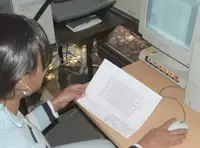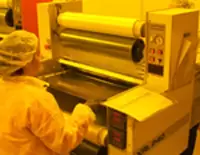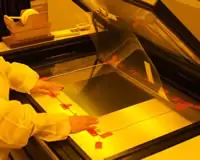The metal etching process starts with your data files in 2-D CAD format. DXF or DWG files are preferred. Tools can also be produced from .ai and EPS files.
 The tool designer creates a compensated rendition of your part geometry that accounts for the etching allowance needed by the metal thickness. Compensation makes the outsides a little bigger and the insides a little smaller on the phototool so that the metal part comes in to the correct dimensions. This version is stepped and repeated and processed to generate a Gerber file for plotting.
The tool designer creates a compensated rendition of your part geometry that accounts for the etching allowance needed by the metal thickness. Compensation makes the outsides a little bigger and the insides a little smaller on the phototool so that the metal part comes in to the correct dimensions. This version is stepped and repeated and processed to generate a Gerber file for plotting.
 Clean, dry metal is laminated with photopolymer film in a safe-light clean room. Avoiding incidences of dust or other debris prevents pinholes or other gaps in the film.
Clean, dry metal is laminated with photopolymer film in a safe-light clean room. Avoiding incidences of dust or other debris prevents pinholes or other gaps in the film.
 The phototool and the laminated metal are precisely positioned in a vacuum frame UV exposure unit. Top to bottom registration is maintained by precision pin punches.
The phototool and the laminated metal are precisely positioned in a vacuum frame UV exposure unit. Top to bottom registration is maintained by precision pin punches.
This link leads to the machine-readable files that are made available in response to the federal Transparency in Coverage Rule and includes negotiated service rates and out-of-network allowed amounts between health plans and healthcare providers. The machine readable files are formatted to allow researchers, regulators, and application developers to more easily access and analyze data.